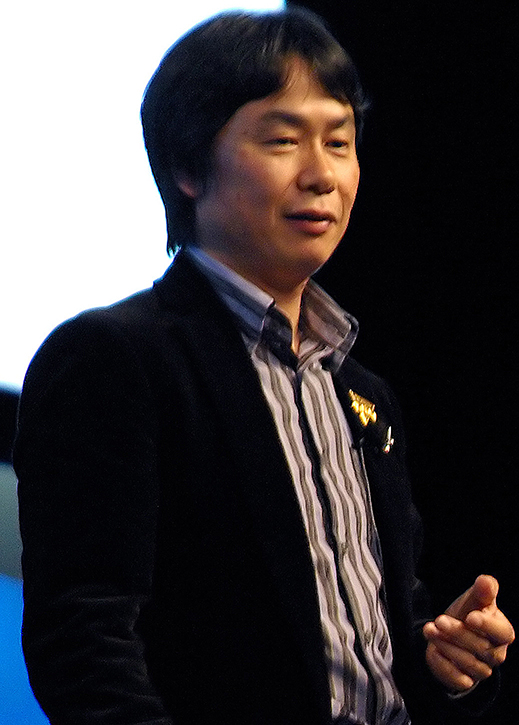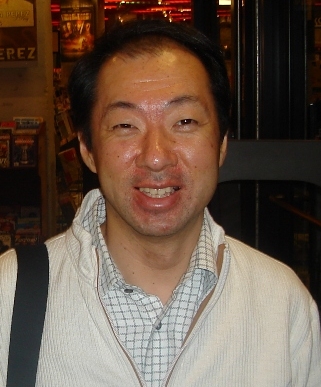|
Super Mario 64
''Super Mario 64'' is a platform game developed and published by Nintendo for the Nintendo 64. It was released in Japan and North America in 1996 and PAL regions in 1997. It is the first ''Super Mario'' game to feature 3D gameplay, combining traditional ''Super Mario'' gameplay, visual style, and characters in a large open world. In the game, Bowser invades Princess Peach's castle, kidnaps her and hides the castle's sources of protection, the Power Stars, in many different worlds inside magical paintings. As Mario, the player traverses levels and collects Power Stars to unlock areas of Princess Peach's castle, in order to reach Bowser and rescue Princess Peach. Director Shigeru Miyamoto conceived a 3D ''Super Mario'' game during the production of ''Star Fox'' (1993). Development lasted nearly three years: about one year on design and twenty months on production, starting with designing the virtual camera system. The team continued with illustrating the 3D character models†... [...More Info...] [...Related Items...] OR: [Wikipedia] [Google] [Baidu] |
Nintendo Entertainment Analysis & Development
commonly abbreviated as Nintendo EAD and formerly known as Nintendo Research & Development No.4 Department (abbreviated as Nintendo R&D4), was the largest software development division within the Japanese video game company Nintendo. It was preceded by the ''Creative Department'', a team of designers with backgrounds in art responsible for many different tasks, to which Shigeru Miyamoto and Takashi Tezuka originally belonged. Both served as managers of the EARD studios and were credited in every game developed by the division, with varying degrees of involvement. Nintendo EAD was best known for its work on games in the ''Donkey Kong'', ''Mario (franchise), Mario'', ''The Legend of Zelda'', ''F-Zero'', ''Star Fox'', ''Animal Crossing'', ''Pikmin'', and ''Wii (video game series), Wii'' series. Following a large company restructuring after the death of company president Satoru Iwata, the division merged with Nintendo's Software Planning & Development division in September 2015, be ... [...More Info...] [...Related Items...] OR: [Wikipedia] [Google] [Baidu] |
G/O Media
G/O Media Inc. is an American media holding company that owns and operates the digital media outlets '' Kotaku'' and '' The Root''. It was formed in 2019 after the private equity firm Great Hill Partners purchased two digital portfolios from Univision: Gizmodo Media Group (''Gizmodo'', Jezebel, '' Deadspin'', '' Lifehacker'', Splinter, ''The Root'', ''Kotaku'', and Jalopnik) and the Onion portfolio ('' The Onion'', ClickHole, '' The A.V. Club'', and ''The Takeout''). , the company has sold off many of its outlets, including ''The Onion'' and ''Gizmodo'', which were the source of "the G and O of its name". History G/O was formed in April 2019 when Great Hill Partners, a private equity firm, purchased the websites from Univision for $18.9 million. Prior to the sale, the former Gawker Media properties had operated as Gizmodo Media Group after being acquired by Univision following the conclusion of the '' Bollea v. Gawker'' lawsuit and subsequent bankruptcy in 2016. Former ... [...More Info...] [...Related Items...] OR: [Wikipedia] [Google] [Baidu] |
Star Fox (1993 Video Game)
''Star Fox'', known as ''Starwing'' in PAL regions, is a 1993 Rail shooter, rail shooter game developed by Nintendo and Argonaut Games, Argonaut Software, and published by Nintendo for the Super Nintendo Entertainment System. The first entry in the ''Star Fox'' series, the story follows Fox McCloud and the rest of the List of Star Fox characters#Star Fox Team, Star Fox team defending their homeworld of Corneria against the invading forces of List of Star Fox characters#Andross, Andross. ''Star Fox'' was the second 3D Nintendo game after ''X (1992 video game), X'' for the Game Boy in 1992, and the first Nintendo game to use polygon (computer graphics), polygonal graphics, achieved with the Super FX graphics chip included in the cartridge. The complex display of three-dimensional models with polygons was uncommon in console games at the time. ''Star Fox'' received critical acclaim and is often considered one of the List of video games considered the best, greatest video games of a ... [...More Info...] [...Related Items...] OR: [Wikipedia] [Google] [Baidu] |
Mario
Mario (; ) is a Character (arts), character created by the Japanese game designer Shigeru Miyamoto. He is the star of the ''Mario (franchise), Mario'' franchise, a recurring character in the ''Donkey Kong'' franchise, and the mascot of the Japanese video game company Nintendo. Mario is an Italian plumber who lives in the Mushroom Kingdom with his younger twin brother, Luigi. Their adventures generally involve rescuing Princess Peach from the villain Bowser while using power-ups that give them different abilities. Mario is distinguished by his large nose and mustache, overalls, red cap, and high-pitched, exaggerated Italian accent. Mario debuted as the player character of ''Donkey Kong (1981 video game), Donkey Kong'', a 1981 platform game. Miyamoto created Mario because Nintendo was unable to license Popeye as the protagonist. The graphical limitations of arcade cabinet, arcade hardware influenced Mario's design, such as his nose, mustache, and overalls, and he was named after ... [...More Info...] [...Related Items...] OR: [Wikipedia] [Google] [Baidu] |
Princess Peach
is a character in Nintendo's Mario (franchise), ''Mario'' franchise. She was created by Shigeru Miyamoto and introduced in the 1985 original ''Super Mario Bros.'' game as Princess Toadstool. She is the Queen regnant, princess regnant and head of state of the Mushroom Kingdom, where she resides in her castle along with Toad (Nintendo), Toads. Since her debut, she has appeared in the majority of ''Mario'' video games as the main female character and the romantic interest of Mario. As the lead female character in the ''Super Mario'' series, Peach's role is typically the damsel in distress who is kidnapped by the main series antagonist, Bowser. In most of the games, her role is to be a captive until she is eventually rescued by Mario. In several multiplayer games of the series, she is a playable character, such as ''Super Mario 3D World'' and ''Super Mario Bros. Wonder''. Outside the series, she has appeared as the protagonist and player character of several video games, includi ... [...More Info...] [...Related Items...] OR: [Wikipedia] [Google] [Baidu] |
Bowser
, also known as King Bowser or King Koopa, is a Character (arts), fictional character and the Antagonist, main antagonist of Nintendo's ''Mario (franchise), Mario'' franchise."The Top 100 Videogame Villains". IGN. Retrieved October 8, 2010. In Japan, he is titled ."Character Introduction". Nintendo Japan. Retrieved October 18, 2009. He is the arch-nemesis of the plumber Mario and the leader of the turtle-like Koopa Troopa, Koopa race. Depicted as a fire-breathing monster with a tyrannical personality, Bowser's ultimate goals are to kidnap Princess Peach and conquer the Mushroom Kingdom.Staff; designed by James Cheung (January 21, 2000). "TenSpot: Top Ten Video Game Villains". GameSpot. Retrieved December 31, 2008. Bowser debuted as Mario's opponent in the 1985 video game ''Super Mario Bros.''McLaughlin, Rus (September 14, 2010). "IGN Presents: The History of Super Mario Bros". IGN. Retrieved October 11, 2021. Designer Shigeru Miyamoto initially conceived him as an ox based o ... [...More Info...] [...Related Items...] OR: [Wikipedia] [Google] [Baidu] |
Open World
In video games, an open world is a virtual world in which the Gamer, player can approach objectives freely, as opposed to a world with more linear and structured gameplay. Notable games in this category include ''The Legend of Zelda (video game), The Legend of Zelda'' (1986), ''Grand Theft Auto V'' (2013), ''Red Dead Redemption 2'' (2018) and ''Minecraft'' (2011). Games with open or free-roaming worlds typically lack level structures like walls and locked doors, or the invisible walls in more open areas that prevent the player from venturing beyond them; only at the bounds of an open-world game will players be limited by geographic features like vast oceans or impassable mountains. Players typically do not encounter loading screens common in linear level designs when moving about the game world, with the open-world game using strategic storage and memory techniques to load the game world dynamically and seamlessly. Open-world games still enforce many restrictions in the game env ... [...More Info...] [...Related Items...] OR: [Wikipedia] [Google] [Baidu] |
3D Computer Graphics
3D computer graphics, sometimes called Computer-generated imagery, CGI, 3D-CGI or three-dimensional Computer-generated imagery, computer graphics, are graphics that use a three-dimensional representation of geometric data (often Cartesian coordinate system#Cartesian coordinates in three dimensions, Cartesian) that is stored in the computer for the purposes of performing calculations and rendering digital images, usually 2D images but sometimes 3D images. The resulting images may be stored for viewing later (possibly as an Computer animation, animation) or displayed in Real-time computer graphics, real time. 3D computer graphics, contrary to what the name suggests, are most often displayed on two-dimensional displays. Unlike 3D film and similar techniques, the result is two-dimensional, without visual depth perception, depth. More often, 3D graphics are being displayed on 3D displays, like in virtual reality systems. 3D graphics stand in contrast to 2D computer graphics which t ... [...More Info...] [...Related Items...] OR: [Wikipedia] [Google] [Baidu] |
PAL Region
Phase Alternating Line (PAL) is a color encoding system for analog television. It was one of three major analogue colour television standards, the others being NTSC and SECAM. In most countries it was broadcast at 625 lines, 50 fields (25 frames) per second, and associated with CCIR analogue broadcast television systems B, D, G, H, I or K. The articles on analog broadcast television systems further describe frame rates, image resolution, and audio modulation. PAL video is composite video because luminance (luma, monochrome image) and chrominance (chroma, colour applied to the monochrome image) are transmitted together as one signal. A latter evolution of the standard, PALplus, added support for widescreen broadcasts with no loss of vertical image resolution, while retaining compatibility with existing sets. Almost all of the countries using PAL are currently in the process of conversion, or have already converted transmission standards to DVB, ISDB or DTMB. T ... [...More Info...] [...Related Items...] OR: [Wikipedia] [Google] [Baidu] |
Koji Kondo
is a Japanese composer and senior executive at the video game company Nintendo. He is best known for his contributions for the '' Super Mario'' and ''The Legend of Zelda'' series, with his ''Super Mario Bros.'' theme being the first piece of music from a video game included in the American National Recording Registry. Kondo was hired by Nintendo in 1984 as its first dedicated composer and is currently a Senior Officer at its Entertainment Planning & Development division. Early life Kondo was born in Nagoya, Japan, on August 13, 1961. Kondo began taking Yamaha Music classes from kindergarten, where he learned to play the electronic organ from the age of five. Kondo also played the marimbas in his elementary school band. He later improved his skills with the electronic organ in a cover band that played jazz and rock music. Kondo studied at the Art Planning Department of Osaka University of Arts, but was never classically trained or academically dedicated to music. With a lov ... [...More Info...] [...Related Items...] OR: [Wikipedia] [Google] [Baidu] |
Yasuhisa Yamamura
is a Japanese video game designer working for Nintendo. He was involved as a level designer in the development of numerous games in the ''Super Mario'' and ''The Legend of Zelda'' series. Speaking about his work on the action-adventure '' The Legend of Zelda: Link's Awakening'', he specified his contributions as the conception of routes, the placement of enemies and the creation of environments. Yamamura's level design philosophy takes into account experienced players skipping areas, with him stressing "the importance of omission and its effects". A regular visitor of amusement arcades, he collects used circuit boards. He is also referred to by the nickname . In 2006, his work on the map and level design of '' New Super Mario Bros.'' was nominated for the National Academy of Video Game Trade Reviewers Award in the category "Game Design". The pigeon character Yamamura that debuted in the platform game ''Super Mario Maker is a 2015 platform game and game creation system develop ... [...More Info...] [...Related Items...] OR: [Wikipedia] [Google] [Baidu] |
Shigeru Miyamoto
is a Japanese video game designer, video game producer, producer and Creative director#Video games, game director at Nintendo, where he has served as one of its representative directors as an executive since 2002. Widely regarded as one of the most accomplished and influential designers in video games, he is the creator of some of the List of video games considered the best, most acclaimed and List of best-selling video game franchises, best-selling game franchises of all time, including ''Mario (franchise), Mario,'' ''The Legend of Zelda'', ''Donkey Kong'', ''Star Fox'' and ''Pikmin''. More than 1 billion copies of games featuring franchises created by Miyamoto have been sold. Born in Sonobe, Kyoto, Miyamoto graduated from Kanazawa College of Art, Kanazawa Municipal College of Industrial Arts. He originally sought a career as a manga artist, until developing an interest in video games. With the help of his father, he joined Nintendo in 1977 after impressing the presi ... [...More Info...] [...Related Items...] OR: [Wikipedia] [Google] [Baidu] |






